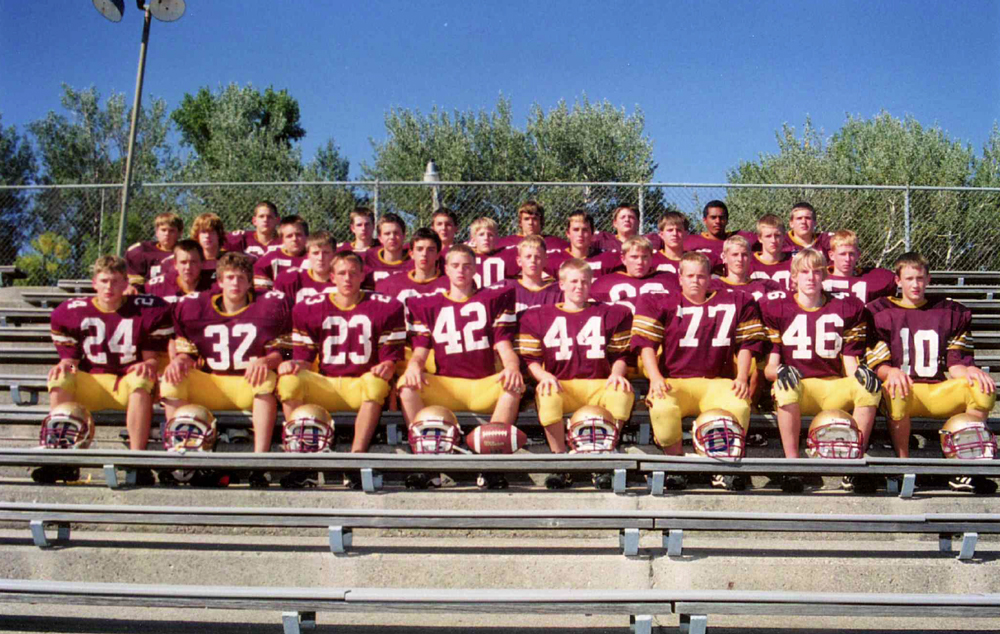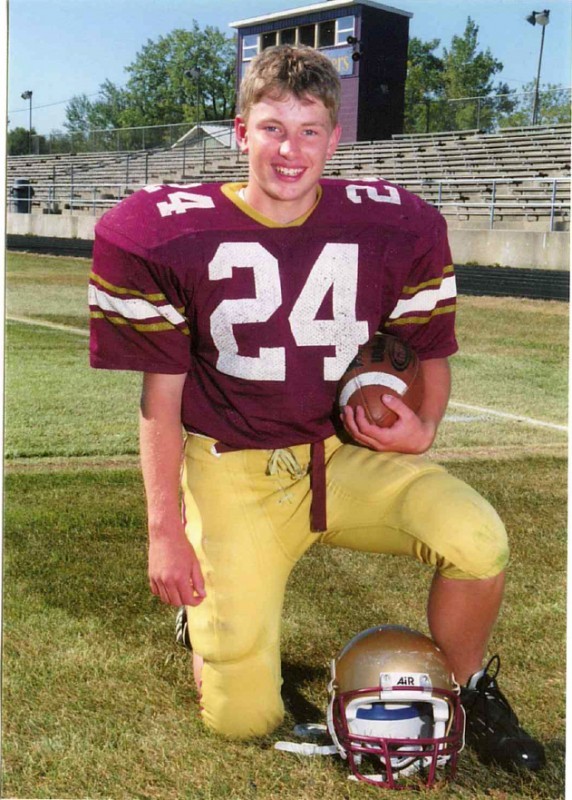
I wore football pads, real pads, like the pros wear, for the first time when I was 12 years old, walking out onto the practice field at the start of my seventh grade season, moms and dads cheering the entire team on before we ran our first wind sprint. I felt so much anticipation before heading out on to that field. I made sure the foam guards fit snug around my knees and thighs and that the contraption wrapped around my shoulders and chest wouldn’t give. I saw the world through a facemask when I put my helmet on, something I’d only experienced through toy helmets up to that point in my life.
All I could think about was how I had waited my whole life for this. I could feel the glory of doing something big, making some catch or tackle in a varsity game in the years to come. I had no idea that I’d be done with football only four years later, that I’d leave the game by my own choice before I finished high school. I quit organized ball my sophomore year without giving any reasons to my coaches or ever really coming up with one for myself.
It wasn’t until the weeks leading up to my graduation from college in 2012 that I found my reason, something I think I knew all along. One of my favorite players, one of the most energetic and enthusiastic linebackers of all time, Junior Seau, was found dead after taking his own life. It sparked a national conversation about the physical toll the game takes on players, especially on professional players who dedicate years to what is potentially killing them. For me, it was a realization of how much I hated the pain everyone experiences playing. Of course, Seau experienced a lot more pain than I ever did. Tests revealed he suffered from CTE, a type of chronic brain damage that was later found in many other players, most likely caused by repetitive hits to the head. But I was finally honest with myself. I quit playing football all those years before because I was afraid of getting hurt. I couldn’t tell anyone at the time, including myself, because of the stigma against quitters, against those who couldn’t take the pain required to play, especially in the conservative part of rural Minnesota where I grew up. There’s so much ritual, so much rite of passage associated with playing junior high and high school football, that quitting is almost akin to leaving a cult.

With how important football is to my family, I remained a loyal fan of both my college and professional teams, but I never played another down. In a family ingrained with football culture that is especially difficult. My father loves to tell stories about the game. From watching his favorite team, the Browns, as a kid growing up in Ohio to attending some of the greatest games in the Orange Bowl when he moved to South Florida as an adult. Even more, he loves telling stories from his days playing.
My older brother, who also quit before he finished high school, likes to talk about the time he broke the leg of the coach’s son in a tackling drill during a summer practice his final season. Though he’s in his thirties now, I can see whenever he tells it that the story still carries a sense of achievement for him.
These two men taught me the game, my father who threw me routes in our back yard, who told me to always come down with the ball whenever it was thrown too high, even if it meant a terrifying hit from a defender. And my brother, who chased me all through the house, picked me up, and threw me down wherever he could, always trying to hit me hardest so I’d be ready for the real thing someday.
Yet I have no football stories to tell, at least no stories of personal glory, no big games that I helped win or hard hits I put on other players. The only memories I really have of the game are times I felt terrible pain, times I really questioned why I even played at all.
The first time was eighth grade, in a game we lost by some large margin, which was how most of our games turned out. I ran with the ball towards the sideline when an opposing player dove and caught my shoulder pads at the back just below the neck, what’s known as a “horse collar” tackle. My full sprint stopped immediately, shoulder pads pulled up to my throat, the full weight of the player cutting off the air in my windpipe.
When I popped up in front of my coach, gasping for air, eyes already watering from the sudden pain, he knew immediately that I wanted to sit out the next few plays.
Frustrated by the score, maybe misreading how hurt I actually was, he yelled, “Fine! Get on the bench!”
I walked over, gasping, trying to breathe through thick mucus that had suddenly formed in my throat, what I thought was blood. I started to cry. To this day, I can’t remember if I played again in that game. I do remember an odd wheeze in my throat for a week or so after.
Still, I pressed on for two more years, that dream of playing in a big game taking me back to the first practice each summer, until another incident when I was a player on the junior varsity. It happened during tackling drills we ran as a team with the older juniors and seniors. In one line was the offense that, one by one, picked up a ball and sprinted over three tackling dummies before trying to avoid a single defender on the other end. The defense, in the other line, took turns popping up off their backs after the whistle, trying to tackle the guy coming at them with the ball.
Somehow I paired up with one of the biggest defensive seniors on the team. He was, I remember, always a nice enough guy outside of football, but turned agitated and mean with the excitement of the drill. After the coach blew the whistle, I only made it to the last dummy. Trying to take the last step over, I caught this senior’s shoulder pad in mid air just above the chest. My helmet popped half off, the chin guard caught on my throat. The world went black for a second and, once I staggered to my feet, I “saw stars” for the first time in my life. Head ringing, I stumbled back to the end of the line. For what it’s worth, the coach complimented my bravery getting back up.
A year later, I tried to forget the whole thing as I sat at home alone while another round of summer practices started a new season. I never wanted to feel pain like that again.
Reflecting on this aspect of my past after Seau’s death and the national discussion on head trauma that followed made me realize that I am part of the last generation to play football before its serious injuries, especially head injuries, were ever a consideration. Between 2010 and 2012, years that coincide with what many consider to be the “concussion crisis” in the NFL, participation in the youth football program Pop Warner dropped 9.5 percent, according to ESPN. I graduated high school in 2007. As someone who really does love the game, it’s difficult to see the number of young players entering high school drop across the country. It’s even more difficult to know I was one of them.
But if the game is going to survive, it’s important to realize that people like me do have stories to tell, just not the ones of glory and triumph. It’s not to make accommodations for weaker players, but to realize the game’s dangerous potential and make changes to an ultra-competitive culture that desperately needs it.
I don’t think you can ever make football entirely safe. I don’t think you ever need to. But a game isn’t enjoyable when it becomes something more than a game, especially something that leaves so much destruction and defeat behind.




Send A Letter To the Editors